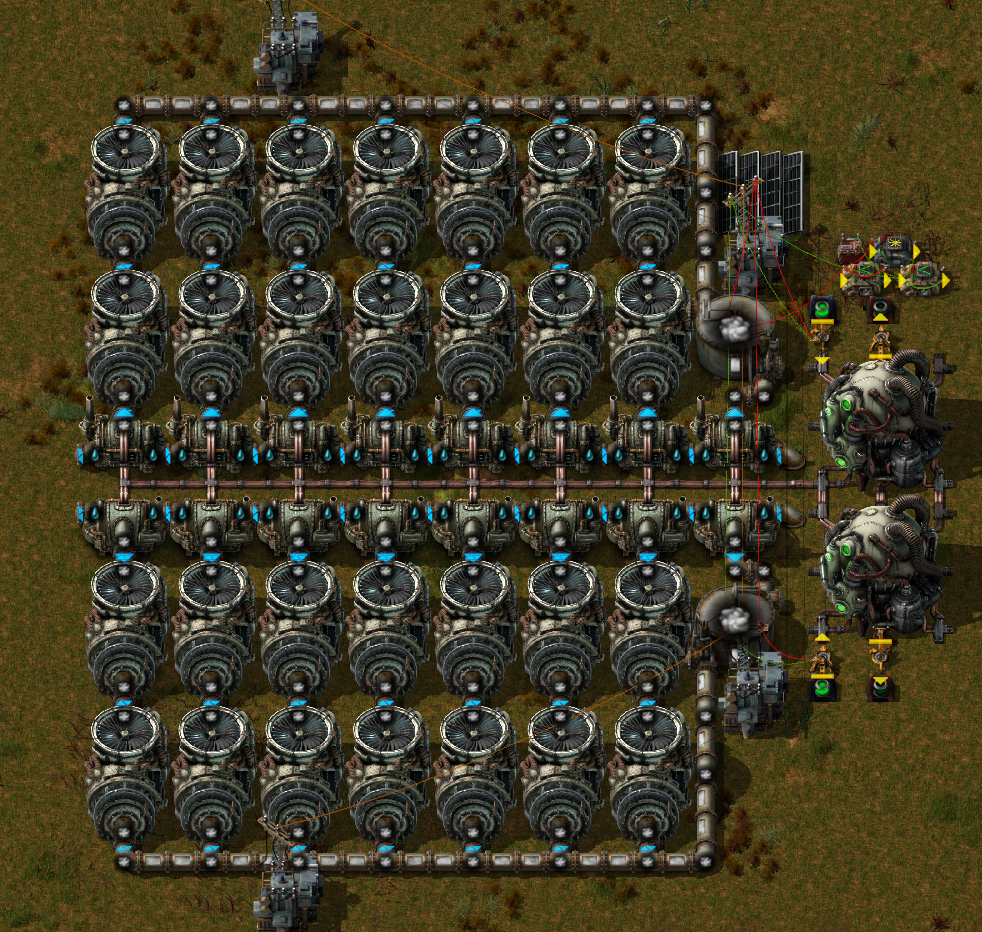
The setup has requester chests, but you could just as easily use a belt as nothing is wired to the chests.


Reactors don't stop when there is no demand and simply heat up to 1000°C and then waste the fuel. So to be efficient your reactor design has to draw out all the heat each fuel cell creates and store it either in heat pipes, in steam tanks or use it. If you assume a minimum 30% load on the reactor that means you don't need to provide heat/steam storage for those 30%. Means you can build the reactor smaller.zOldBulldog wrote:- What happens when demand drops below the 30% level (around 50MW) you warn about?

So, nothing wrong then to using this design for an early plant that gets replaced soon after, except for some fuel waste. Just go to a design that "fully converts unused fuel to stored steam and then shuts down until the steam is consumed before restarting" when upgrading to the larger design. Correct?mrvn wrote:Reactors don't stop when there is no demand and simply heat up to 1000°C and then waste the fuel. So to be efficient your reactor design has to draw out all the heat each fuel cell creates and store it either in heat pipes, in steam tanks or use it. If you assume a minimum 30% load on the reactor that means you don't need to provide heat/steam storage for those 30%. Means you can build the reactor smaller.zOldBulldog wrote:- What happens when demand drops below the 30% level (around 50MW) you warn about?
But if you don't use those 30% then the reactor simply reaches 1000°C and waste the fuel. Nothing should break down ever due to that.
It conserves fuel by exploiting the very large heat capacity (and perfect insulation!) of nuclear reactor components. Basically, the setup is allowed to cool down to nearly 500 degrees, then fuel is inserted which heats it up to nearly 1000 degrees, the stored heat runs the heat exchangers until it cools back down to nearly 500 degrees and that cycle repeats (note that reactor setups never lose heat to the environment, the only way it cool down is heat exchangers removing heat to make steam, thus heat storage enjoys perfect effeciency).zOldBulldog wrote: - Does this design conserve fuel when not needed? Or are more steam tanks essential for that?
During a fuel burning cycle the reactors will sometimes reach 1000 degrees causing a small portion of the fuel to be wasted as there is nowhere for the heat to go. There is no danger of brownouts with this setup regardless of what you do. That was a deliberate design decision I made: I decided it was more important to avoid any possibility of a brownout than any possibility of wasting fuel.- What happens when demand drops below the 30% level (around 50MW) you warn about? Just a brownout that can be easily covered by backup steam/solar power and then it reengages when demand goes up? Or does it shut down and require a manual restart?
It's designed to be placable by blueprint and starts itself up automatically once there are fuel cells in the requester chests. But note that if only one chest has a fuel cell, only one fuel cell will be inserted and for that fuel cycle only one reactor will be running. Typically this shouldn't be a problem because it'll correct itself on the next fuel cycle 200s later, but if it is a problem just manually insert 1 fuel cell into the empty reactor - or put fuel into both chests before hooking it up to the power grid. The setup is highly resistant to operator error, if you randomly shove fuel cells into reactors it won't cause any serious problems.- Speaking of that, is there a manual start sequence, or does this design start on its own?
Yeah in the OP I mention that using double rows of heat pipes would be an effective way of scaling up the heat storage, and that heat pipes have about twice the energy storage density (per tile) as steam tanks.mrvn wrote:You can also just add a few extra heat pipes or steam tanks (without wires) to get more buffering. Heat pipes should also allow you to extend this to 4 reactors without extra heat exchangers or turbines. They just have to be able to buffer 3 times as much heat. Makes it 3 times as fuel efficient.
In practice I've found that once the entire setup is at at least 500 degrees, heat spreads very quickly across it, so the steam stored in the measuring tanks, turbines and pipes tends to be enough.mrvn wrote: So maybe not just a double row of heat exchangers. How about 6 rows so the heat pipe connects to 4 points (2 each) on the reactors?
480MW Square Version:JackGruff wrote:I've been using this for about 60+ hours in a game, seems to work very well.
Could you please make a 4 reactor version?
As said, this image is just an extract to show it, I'm not using tanks, nor external pipes, cause I didn't need it. It's an old design and it was in the middle just to save it.mrvn wrote: Mon Jan 28, 2019 11:24 am The steam tanks seem badly placed with only one pipe leading in and out of them. When combing nuclear with solar power you could need twice the throughput from the tank compared to the heat exchangers.
While not designed for a full night-only nuclear setup I would suggest this: Place the first row of turbines directly after the heat exchangers. Only then have the row of pipes. The places where there is no second turbine can then be filled by a tank.
Note: For a full night-only nuclear setup you would need ~3 times the turbines and who knows how many tanks in a 4 turbines, 2 tanks, 2 turbines setup.

